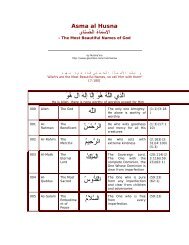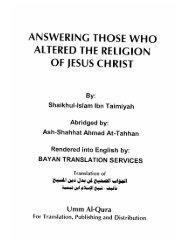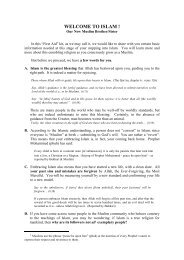You also want an ePaper? Increase the reach of your titles
YUMPU automatically turns print PDFs into web optimized ePapers that Google loves.
A <strong>Brief</strong> <strong>Guide</strong> to the <strong>Rites</strong> of <strong>Hajj</strong> and ‘<strong>Umrah</strong><br />
If a woman commences her menstrual bleeding after completing the first Tawaaf (Tawaaf al-<br />
Qudoom), then she must complete all the remaining rites of <strong>Hajj</strong> (like the other women of<br />
<strong>Hajj</strong>), except that she must wait to become clean at the end of her menses in order to<br />
perform the Tawaaf al-Ifaadah (<strong>The</strong> Tawaaf of Return).<br />
Her <strong>Hajj</strong> or ‘<strong>Umrah</strong> are not ruined, as some ignorant people presume; rather her <strong>Hajj</strong> is valid<br />
and her ‘<strong>Umrah</strong> is valid. Allaah has indeed written this for all of the daughters of Aadam;<br />
therefore, women will experience menses.<br />
So there is no problem for women experiencing menses to complete all of the rites of <strong>Hajj</strong>,<br />
except the Tawaaf around the House. <strong>The</strong>y must wait until becoming clean and purified after<br />
the completion of the menses, before performing the Tawaaf again.<br />
Another case is when a woman commences her menstrual bleeding before performing the<br />
Farewell Tawaaf (Tawaaf al-Widaa’). Is it necessary for her to wait until the end of her<br />
menses, become purified, and then perform the Tawaaf al-Widaa?<br />
No, in this case, the Tawaaf Al-Ifaadah ("the Tawaaf of return (from Minaa) that was<br />
performed earlier will suffice for both the Tawaaf al-Ifaadah as well as the Tawaaf al-Widaa'.<br />
<strong>The</strong>se is no need for a woman to wait until becoming purified; she can complete the<br />
remaining rites of <strong>Hajj</strong> during the final days without having to perform the Tawaaf al-Widaa',<br />
and depart home with her family.<br />
This concludes a summary of the ordered rites of ‘<strong>Umrah</strong> and <strong>Hajj</strong>.<br />
THE PREFERABILITY OF HAJJ AT-TAMATTU'<br />
<strong>The</strong>re is no doubt that the best form of <strong>Hajj</strong> is the <strong>Hajj</strong> at-Tamattu'” (i.e. joining the ‘<strong>Umrah</strong><br />
to the <strong>Hajj</strong> while coming out of Ihraam for a period in between).<br />
This is the type of <strong>Hajj</strong> that we have just explained: <strong>To</strong> perform the ‘<strong>Umrah</strong>, come out of<br />
Ihraam, then put on the Ihraam for <strong>Hajj</strong>. This division between the two sacred states of<br />
Ihraam is known as “At-Tamattu' “.<br />
A person may say: "<strong>The</strong> Prophet (sallAllaahu ‘alayhi wa sallam) never performed <strong>Hajj</strong> at-<br />
Tamattu', for he only performed the <strong>Hajj</strong> al-Qiraan.” 3<br />
Since the Prophet (sallAllaahu ‘alayhi wa sallam) remained in his Ihraam due to his <strong>Hajj</strong> al-<br />
Qiraan, how can we say that <strong>Hajj</strong> at-Tamattu' is best when the Prophet never performed<br />
3 Translator’s Note: <strong>Hajj</strong> al-Qiraan is when the pilgrim joins the ‘<strong>Umrah</strong> and the <strong>Hajj</strong> without coming<br />
out of Ihraam in between, staying in the sacred state of Ihraam from the first time it was entered into<br />
(at the Meeqaat) until the final rite (of slaughtering the hadee (sacrificial animal).<br />
www.al-manhaj.com Al-Manhaj E-Books<br />
25










![Al-Quran - The Miracle of Miracles [ deedat]](https://img.yumpu.com/4137688/1/190x245/al-quran-the-miracle-of-miracles-deedat.jpg?quality=85)






![A Collection Of Wise Sayings [ Al-Fawaid ].pdf](https://img.yumpu.com/4135801/1/190x245/a-collection-of-wise-sayings-al-fawaid-pdf.jpg?quality=85)
